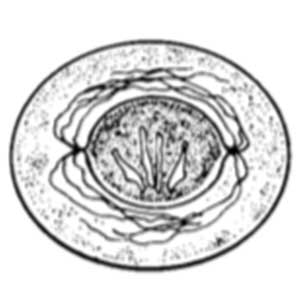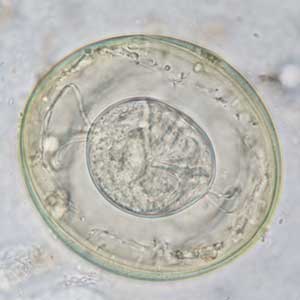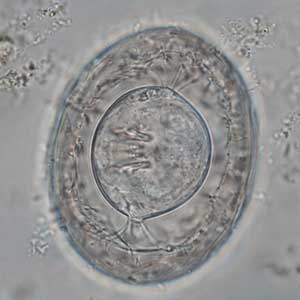Hymenolepis nana is a cestode of the small intestine of primates.
Epidemiology
Hymenolepis nana is a cosmopolitan parasite which can be found in all groups of primates. It has namely been described in macaques (Macaca spp.), squirrel monkeys (Saimiri sciureus), chimpanzees (Pan spp.) and ring-tailed lemurs (Lemur catta) amongst others (Strait et al., 2012; Calle & Joslin, 2015; Crouch et al. 2022). It is the most frequently reported cestode in captive non-human primates.
Description
Hymenolepis nana eggs are round to oval and contain an hexacanth embryo with polar filaments in equatorial position. Eggs typically measure 35 to 50 µm in diameter (Global Health, Division of Parasitic Diseases and Malaria, 2017).
Differential diagnosis
Differential diagnosis includes other cestode eggs and pollen seeds. However:
- Although Bertiella eggs are round and of similar size as Hymenolepis nana eggs (35 to 50 µm in diameter), they have a pyriform apparatus around their hexacanth embryo (Global Health, Division of Parasitic Diseases and Malaria, 2019a); moreover, Bertiella mainly affects Old-World Monkeys and Apes and is less frequent than Hymenolepis in captive non-human primates (Brack, 2002);
- Hymenolepis diminuta eggs are larger (70 to 85 µm in diameter) and their hexacanth embryo lacks polar filaments (Global Health, Division of Parasitic Diseases and Malaria, 2017); moreover, diminuta can affect Old and New World Monkeys as well as Apes;
- Although barley (Hordeum vulgare) pollen seeds are of the similar size as Hymenolepis nana eggs, they are generally oval, have a thin membrane and homogeneous content; moreover, they do not have neither an hexacanth embryo nor polar filaments (Petithory, 1995).
Clinical significance
Infections by Hymenolepis nana are generally asymptomatic. In rare occasions, clinical signs like diarrhea, abdominal pain and lethargy can appear. An important parasite load can also induce abscess formation in the mesenteric lymph nodes of affected animal (Strait et al., 2012; Calle & Joslin, 2015).
Prophylaxis and treatment
As Hymenolepis nana is zoonotic and transmission occurs by direct contact with parasite eggs, hygienic measures need to be taken in case of diagnosis.
Various treatments have been described in non-human primates:
- Niclosamide: 100 mg/kg once (Strait et al., 2012);
- Bunamidine hydrochloride: 25 to 100 mg/kg once (Strait et al., 2012);
Praziquantel: one injection of 5.68 mg/kg or 1.25 mg/animal PO (Strait et al., 2012).











